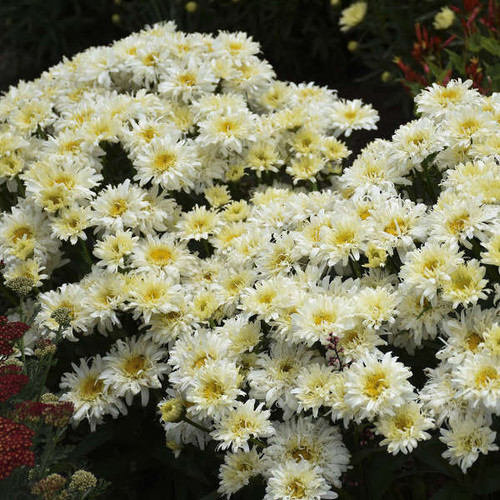Product Description
Leucanthemum s. 'Ice Cream Dream' PPAF (30)ct Flat
Common Name: Shasta Daisy
Like little scoops of ice cream, this Shasta Daisy will charm you as it comes into focus in early to midsummer. Intense yellow buds open cream and expand to be near white, fully double, pom-pom-like flowers with small yellow centers. The flowers are 2½-3' wide and totally cover the compact habit of dark green foliage.
Height: 12.0 Inches
Spread: 18.0 Inches
Hardiness Zones: 5,6,7,8,9
Flower Color: White Shades
Foliage Color: Green shades
Full Sun
Low to Average Water Needs
Average to Fertile Soil Quality
Bloomtime: Early Summer to Midsummer
Attracts Butterflies
Bee Friendly
Growth Rate: Medium
Border Plant, Cut Flower, Easy To Grow
Leucanthemum 'Ice Cream Dream' is a delightful and unique Shasta daisy known for its charming double blooms and creamy white petals. Here is a breakdown of what makes it special:
- Double Flowers: Unlike typical Shasta daisies with single rows of petals, 'Ice Cream Dream' boasts fully double flowers. This gives them a fuller, more substantial appearance, resembling a scoop of ice cream (hence the name!). The center of the flower may have a slight yellowish tint when first opening, further adding to the "ice cream" effect.
- Creamy White Petals: The petals are a lovely, soft creamy white, not stark white. This subtle difference adds warmth and elegance to the flowers.
- Compact Growth Habit: 'Ice Cream Dream' has a compact and bushy growth habit, typically reaching around 18-24 inches in height and width. This makes it a great choice for smaller gardens, borders, containers, or even as a filler in mixed plantings.
- Long Blooming Period: Shasta daisies are known for their long blooming period, and 'Ice Cream Dream' is no exception. It will produce flowers from late spring or early summer through fall, especially with regular deadheading. This extended bloom time provides continuous color in the garden.
- Attracts Pollinators: Like other daisies, 'Ice Cream Dream' attracts pollinators such as butterflies and bees to the garden.
- Easy Care: This Leucanthemum is relatively low-maintenance and easy to grow. It is drought-tolerant once established and generally pest and disease resistant.
Here are some additional points to consider about Leucanthemum 'Ice Cream Dream':
- Sunlight: It thrives in full sun, requiring at least 6 hours of direct sunlight per day for best blooming.
- Soil: It prefers well-drained soil. Heavy, wet soil can lead to root rot.
- Watering: While drought-tolerant once established, regular watering, especially during the first year, will help it establish a strong root system. Avoid overwatering.
- Deadheading: Regularly removing spent flowers (deadheading) will encourage more blooms and keep the plant looking tidy.
- Division: Over time, clumps may become crowded. Division every few years in spring or fall will help maintain vigor.
- Hardiness: It is generally hardy in USDA zones 5-9, making it suitable for a wide range of climates.
Leucanthemum 'Ice Cream Dream' is a charming and easy-to-grow perennial that will add a touch of whimsy and elegance to your garden. Its unique double flowers, creamy white petals, and long blooming period make it a versatile choice for various garden settings. Whether you are looking for a border plant, a container specimen, or a cut flower, 'Ice Cream Dream' is a great option.
Thirty (30) plants per flat (or tray). Approximate Plug Measurements: 3in deep x 2in wide.
Other Details
The most important part of the plant is its root system. Healthy roots are the foundation of a healthy, vibrant plant. The type of plug container used is based on the specific needs of the plants. Perennials offered as bare root traditionally perform better when planted as bare root.Planted in a specialized mix, potted plants have well established root systems. Top growth stage will vary depending on the current life cycle and time of year when shipped. In Winter and early Spring dormant plants may be shipped. Dormant plants may be planted right away, even before the last frost date.
Most bare root varieties are field grown for at least one season, though Hemerocallis and Hosta are grown for two seasons. The bulk of the soil is removed during the harvesting process and the tops of most varieties are trimmed back to the crown. They are graded, packed in shredded aspen or sphagnum moss and stored in freezers until ready to be shipped.
See our Container Sizes and Bare Root Perennials pages for more information.
Plant information and care is provided in the Overview section, Plant Genus Page and general information is provided in the Planting Care & Guides. Additional questions can be asked on each Plant page.
Plant Spacing: Using the maximum mature spread or width of a plant to guide spacing, ensures space to grow to full size. To fill an area sooner, plant them closer together. Just remember, future thinning or transplanting may be needed.
Water: Keep a close eye on newly planted perennials, especially throughout the first growing year. Most early plant loss is due to too much or too little water!











